China |
|
|
|
| Übersicht – Contents: | |
China |
|
|
|
| Übersicht – Contents: | |
Flaggen – Flags: |
|
 |
National- und Handelsflagge – national and merchant flag, Seitenverhältnis – ratio = 2:3, Quelle/Source: Corel Draw 4, Wikipedia (EN) |
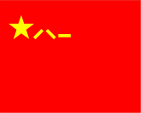 |
Flagge der Streitkräfte – flag of the Armed Forces, Seitenverhältnis – ratio = 5:4, Quelle/Source: nach/by: Wikipedia (EN) |
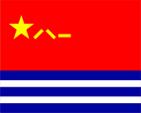 |
Marineflagge – naval flag, Seitenverhältnis – ratio = 5:4, Quelle/Source: nach/by: Wikipedia (EN) |
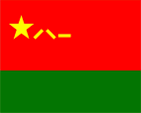 |
Flagge des Heeres – flag of the Army, Seitenverhältnis – ratio = 5:4, Quelle/Source: nach/by: Wikipedia (EN) |
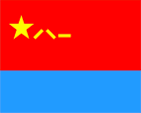 |
Flagge der Luftwaffe – flag of the Air Force, Seitenverhältnis – ratio = 5:4, Quelle/Source: nach/by: Wikipedia (EN) |
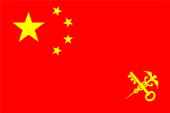 |
Zollflagge – customs flag, Seitenverhältnis – ratio = 2:3, Quelle/Source: nach/by: Wikipedia (EN) |
historische Flaggen – historical Flags: |
|
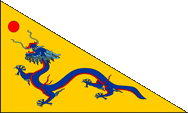 |
1872–1889, Flagge des Kaiserreichs – flag of the empire, Quelle/Source nach/by: Flags of the World, !Original:清朝政府Vector: Sodacan, Public domain, via Wikimedia Commons |
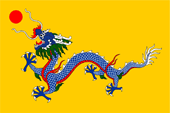 |
1889–1911, Flagge des Kaiserreichs – flag of the empire, Quelle/Source nach/by: Flags of the World, !Original:清朝政府Vector: Sodacan, Public domain, via Wikimedia Commons |
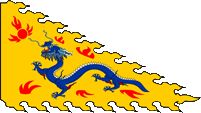 |
1862(?)–1911, Flagge des Kaisers – flag of the emperor, Quelle/Source nach/by: Flags of the World !Original:清朝政府Vector: Sodacan, Public domain, via Wikimedia Commons |
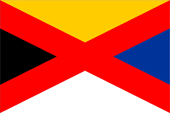 |
1915–1916, Kaiserreich China – Empire of China, National- und Handelsflagge – national and merchant flag, Quelle/Source nach/by: Flags of the World, Wikipedia (DE) |
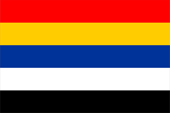 |
1912–1928, National- und Handelsflagge – national and merchant flag, Quelle/Source nach/by: Flags of the World, Wikipedia (EN) |
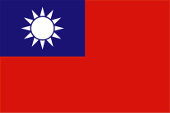 |
1912–1928, Marineflagge – naval flag, Seitenverhältnis – ratio = 2:3, Quelle/Source nach/by: Die Welt im bunten Flaggenbild |
 |
1928–1949, National-, Staats- und Marineflagge – national, state and naval flag, Seitenverhältnis – ratio = 2:3, Quelle/Source nach/by: Die Welt im bunten Flaggenbild |
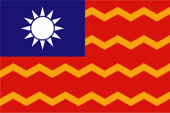 |
1929–1949, Handelsflagge – merchant flag, Seitenverhältnis – ratio = 2:3, Quelle/Source nach/by: Die Welt im bunten Flaggenbild |
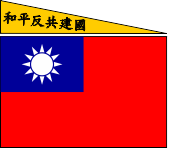 |
1940–1945, Flagge Chinas unter der Nanking-Regierung – flag of China under the Nanking Government, Quelle/Source nach/by: Der neue Brockhaus |
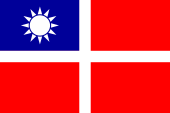 |
1942–1945, Marineflagge Chinas unter der Nanking-Regierung – naval flag of China under the Nanking Government, Quelle/Source nach/by: Wikipedia (EN) |
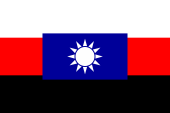 |
seit/since 1948/1949, Revolutonäres Komitee der Guomindang – Revolutionary Committee of the Kuomintang, Seitenverhältnis – ratio = 2:3, Quelle/Source nach/by: Jürgen Kaltschmitt |
Bedeutung/Ursprung der Flagge – Meaning/Origin of the Flag: |
|
| Die
Flagge des chinesischen Kaiserreichs der Qing-Dynastie war einfarbig gelb
und zeigte einem blauen Drachen in der Mitte. Die Farbe Gelb ist die Farbe
des Volkes der Mandschuren und auch der mandschurischen Qing-Dynastie, die
1644 bis 1911 China beherrschte. Der Drache steht für den Osten. Eine Flagge im europäischen Stil wurde erst 1889 eingeführt. Vorher waren die chinesischen Flaggen wie Wimpel geformt. |
The flag of the Chinese empire of the Quing Dynasty was single coloured yellow bunting and showed a blue dragon in the middle. The color yellow is the color of the Mandshu-People and as well of the Manchurian Qing dynasty, which ruled over China between 1644 and 1911. The dragon stands for the East. A flag in european style was initially introduced in 1889. The Chinese flags were shaped like pennants in the times before. |
| Quelle/Source: Die Welt der Flaggen, Flaggen und Wappen der Welt | |
| Im Jahre 1911 wurde die Monarchie gestürzt, und die Republik ausgerufen. In diesem Zusammenhang wurde eine neue Flagge eingeführt. Es war die Flagge der ehemaligen Provinz Jangtse. Sie zeigte fünf waagerechte Streifen in Rot, Gelb, Blau, Weiß und Schwarz. Die fünf Farben sollten die fünf Rassen Chinas repräsentieren: Rot = Han-Chinesen, Gelb = Mandschuren, Blau = Mongolen, Weiß = Hui und Turkestaner (Uiguren), Schwarz = Tibeter. Das Rot der Han-Chinesen, des dominanten Volkes, lag natürlich oben. | In the year 1911 the monarchy was unseated, and the republic was proclaimed. In this context a new flag was introduced. This was the flag of the former province of Yangtse. It showed five horizontal stripes in red, yellow, blue, white and black. The five colors should represent the five races of China: red = Han-Chinese, yellow = Manchurians, blue = Mongolians, white = Hui and Turkestanians (Uigurs), black = Tibetans. Red is the colour of the Han-Chinese – the dominant mayority – it was typical above. |
| Quelle/Source: Die Welt der Flaggen, Flags of the World | |
| Präsident und Oberbefehlshaber Yuan Shikai versuchte von Ende 1915 bis Anfang 1916 das Kaiserreich China wieder herzustellen, und zwar unter seiner eigenen Dynastie "Hongxian". Die Flagge des Hongxian-Kaiserreichs orientierte sich der fünfstreifigen Flagge der Republik. Das über allem liegende rote Kreuz symbolisierte die Herrschaft der Han-Chinesen über die Völker der Mandschuren, Mongolen, Uiguren und Tibeter. | President
and Commander Yuan Shikai tried from the end of 1915 until early 1916 to
restore the Empire of China, under its own dynasty "Hongxian". The flag of the Hongxian Empire was oriented the flag of the Republic with the five stripes. The lying all over red cross, symbolized the rule of the people of Han-Chinese, over the peoples of the Manchu, Mongolian, Uyghur and Tibetan. |
| Quelle/Source: Flags of the World | |
| Schon im Jahr 1895 hatte sich eine Reformbewegung organisiert, die chinesische Regenerationsgesellschaft. Die Flagge dieser Organisation war einfarbig blau, mit einer weißen zwölfstrahligen Sonne in der Mitte. Im Jahre 1912 wurde die nationalrepublikanische Guomindang-Partei gegründet. Die Guomindang wählten sich eine einfarbige rote Flagge mit der blauen Flagge der Regenerationsgesellschaft in der Oberecke. Die gleiche Flagge wurde schon im gleichen Jahr als Marineflagge eingeführt. In einem langen Bürgerkrieg konnten sich die Guomindang im Jahre 1928 letzlich durchsetzen. Die Flagge der Guomindang wurde zur neuen Nationalflagge, die auf Taiwan noch immer verwendet wird (siehe Taiwan). | Already
in the year 1895 has established a reform movement, the Chinese Society of
Regeneration. The flag of this organization was a blue flag, with a white
sun with twelve beams in the middle of the flag.
In the year 1912 was established the national-republican Kuomintang party.
The Kuomintang choosed a single colour red flag with the blue flag of the
regeneration society in the upper canton. |
| Quelle/Source: Die Welt der Flaggen, Wikipedia (DE) | |
| Im Jahre 1935 gelang es den Kommunisten sich in der Provinz Shanxi festzusetzen. Ihre "Volksbefreiungsarmee" verwendete eine einfarbig rote Flagge mit einem goldenen Stern in der Oberecke sowie mit den Zahlen "1" und "8". Sie erinnern an das Gründungsdatum der Truppe, den 1. August 1928. Diese Flagge ist noch heute die Flagge der Streitkräfte Chinas. | In the year 1935 the communists succeed to establish themself in the province Shanxi. Their "people liberation army" used a single-coloured red flag with a golden star in the upper canton as well as with the numbers "1" and "8". They remember the date of foundation of the unit, the 1st of August 1928. This flag is until today flag of the armed forces of China. |
| Quelle/Source: Die Welt der Flaggen, Atlas zur Geschichte | |
| Im Jahre 1931 hatten die Japaner die Mandschurei besetzt, und den Satellitenstaat Mandschukuo installiert. 1937 kam es zum zweiten chinesisch-japanischen Krieg, und Japan besetzte große Teile Chinas. Im Norden der Inneren Mongolei wurde der Satellitenstaat Mengjiang installiert. In Nanking (Nanjing) war bis 1945, dem Jahr des Abzugs der Japaner, eine projapanische Regierung für China eingesetzt. Diese verwendete weiterhin die Flagge der Guomindang, jedoch um einen gelben Wimpel ergänzt, auf dem stand: "Frieden, Antikommunismus, Nationaler Aufbau". | In the year 1931 the Japanese had occupied Manchuria, and they established the puppet state of Manchoukuo. In 1937 began the second Chinese-Japanese war, and Japan occupied large parts of China. In the north of Inner Mongolia they established the puppet state of Mengjiang. In Nanking (Nanjing) was installed (to 1945, the year of withdrawal of the Japanese) a pro-Japanese government for China. This continued the use of the flag of the Kuomintang, however added by a yellow pennant and on it was written: "Peace, Anti-Communism, National Construction". |
| Quelle/Source: Atlas zur Geschichte, Wikipedia (EN), Der neue Brockhaus | |
| Im "Herbst-Abkommen" vom Oktober 1945 vereinbarten Tschiang-Kai-Schek (Guomindang) und Mao-Tse-Tung (Kommunisten) eine gegenseitige Waffenruhe und auch Wahlen zu einer Volksvertretung. Infolge dessen verwendete die KP Chinas neben ihrer roten Partei-Flagge mit Hammer und Sichel – zumindest bei Wahlkampfveranstaltungen – die Flagge der Republik China mit der weißen Sonne als Nationalflagge. Als der Bürgerkrieg 1946 wieder offen ausbrach, wurde diese Praxis wieder eingestellt. | In the
"Autumn Agreement" from October 1945 Chiang Kai Shek (KMT) and Mao Tse-Tung
(Communists) agreed a mutual ceasefire and even elections for a
representative assembly.
As a result, the Communist Party of China used in addition to their red party flag with hammer and sickle – at least in campaign events – the flag of the Republic of China with the white sun, as the national flag. When the Civil War broke out open again in 1946, this practice ends. |
| Im folgenden Bürgerkrieg, der bis 1949 dauerte, setzten sich die Kommunisten gegen die Guomindang duch. Diese konten sich nach Taiwan retten. Die Insel verwendet bis heute die Flaggen der Guomindang. Am 01.10.1949 wurde durch die siegreichen Kommunisten die Volksrepublik China gegründet, und eine neue Flagge eingeführt. Sie ist einfarbig rot mit einem großen und vier kleinen goldenen fünfzackigen Sternen in der Oberecke. Das Rot steht für den Kommunismus, aber auch noch immer für die Han. Die fünf Sterne symbolisieren China, Mandschurei, Mongolei, Sinkiang (Ostturkestan) und Tibet, aber auch die kommunistische Partei und die vier Werktätigenklassen: Arbeiter, Bauern, Kleinbürger und "patriotische Kapitalisten". | In the
following civil war, which endures until 1949, the communists were
victorious against the Kuomintang. These rescued themselves to Taiwan. The
island uses the flags of the Kuomintang until today. On 1st of October in 1949 was established the People's Republic of China by the victorious communists, and they introduced a new flag. It is a single coloured red flag with one large and four smaller golden five-pointed stars in the upper canton. Red stands for the communism, but even for the Han, too. The five stars symbolize China, Manchuria, Mongolia, Sinkiang (East Turkestan) and Tibet, but furthermore the communist party and the four working classes: workers, farmers, citizens and "patriotic capitalists". |
| Quelle/Source: Flaggen Wappen Hymnen | |
Wappen – Coat of Arms: |
|
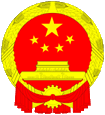 |
Wappen der Volksrepublik China – coat of arms of the People's Rep. of China, Quelle/Source: Corel Draw 4 |
historische Wappen – historical Coats of Arms: |
|
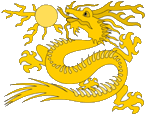 |
bis/to 1911, Wappen des Kaiserreichs China – coat of arms of the Empire of China |
 |
1928–1949 (auf Taiwan bis heute – on Taiwan until today) Wappen der Republik China – coat of arms of Republic of China, Quelle/Source: Corel Draw 4 |
Bedeutung/Ursprung des Wappens – Meaning/Origin of the Coat of Arms: |
|
| Das Sinn- und Wappenbild des Kaiserreichs China war der Drache. Er war das Symbol der mandschurischen Qing-Dynastie, die zwischen 1644 und 1911 China beherrschte. | The symbol and emblem of the Empire of China was the dragon. It was the symbol of the Manchurian Qing dynasty, which ruled China between 1644 and 1911. |
| Die im Bürgerkrieg der Republik China siegreichen Guomindang führten im Jahre 1928 als neues Landeswappen ihr eigenes Emblem ein. Es geht auf das Logo der chinesischen Regenerationsgesellschaft von 1895 zurück und zeigt eine weiße, zwölfstrahlige Sonne auf einer blauen Scheibe. Sie erinnert an die zwölf Zwei-Stunden-Abschnitte des Tages und symbolisiert so den Geist des unaufhaltsamen Fortschritts. Das Wappen wird auf Taiwan noch immer verwendet (siehe Taiwan). | The in the civil war of the Republic of China victorious Kuomintang introduced in 1928 its own emblem as the new national emblem. It goes back to the logo of the Chinese Society of Regeneration from 1895 and shows a white, twelve-pointed sun on a blue disc. It is reminiscent of the twelve two-hour parts of the day, symbolizing the spirit of unstoppable progress. The emblem is still used in Taiwan (see Taiwan). |
| Das Wappen der Volksrepublik China wurde am 20.09.1950 eingeführt. Es zeigt in Gold auf Rot das Tor zur Verbotenen Stadt am Platz des Himmlischen Friedens, den Mittelpunkt, das Zentrum der Macht in der Hauptstadt des Landes. Darüber die fünf goldenen Sterne aus der Flagge. Das Ganze ist umgeben von einem Kranz aus Weizen- und Reisähren. Sie stehen für die Landwirtschaft und werden im unteren Teil des Wappens durch rote Fahnen mit einem Zahnrad verbunden, das für die Industrie steht. | The coat of arms of the People's Republic of China was introduced on 20th of September in 1950. It shows in gold on red the gate to the Forbidden City on Tiananmen Square, the midpoint, the center of power in the capital of the country. Above the five golden stars from the flag. The whole is surrounded by a wreath of wheat and rice grains. They stand for the agriculture, and in the lower part of the arms they are connected by red flags with a gear, which stands for the industry. |
| Quelle/Source: Wappen und Flaggen aller Nationen, Flaggen Wappen Hymnen | |
Flugzeugkokarde – aircraft roundel: |
|
 |
1916-1920, Flugzeugkokarde – aircraft roundel Quelle/Source nach/by: Wikipedia (EN) |
 |
1920-1928, Flugzeugkokarde – aircraft roundel Quelle/Source nach/by: Wikipedia (EN) |
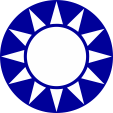 |
1928-1949, Flugzeugkokarde – aircraft roundel Quelle/Source nach/by: Wikipedia (EN) |
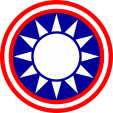 |
1942-1945, Flugzeugkokarde unter der Nanking-Regierung – aircraft roundel under the Nanking Government, Quelle/Source nach/by: Wikipedia (EN) |
 |
seit/since
1949, Flugzeugkokarde – aircraft roundel Quelle/Source nach/by: Wikipedia (EN) |
| Landkarten – Maps: |
Lage – Position: |
Landkarte des Landes – Map of the Country: |
Zahlen und Fakten – Numbers and Facts: |
|
|
|
|
|
|
|
|
|
|
|
|
|
|
|
|
|
|
|
Geschichte: |
|
20.–15. Jhd. v.Chr. · Hsia-Dynastie 15.–11. Jhd. v.Chr. · Shang-(Yin-)Dynastie 11. Jhd.–249 v.Chr. · Dschou-Dynastie 221–206 v.Chr. · Tjin-(Qin-)Dynastie 206 v.Chr.–220 · Han-Dynastie 265–420 · Djin-Dynastie 386–598 · China zerfällt in Teilreiche 618–907 · Tang-Dynastie 960–1120 · Sung-(Song-)Dynastie 1234 · Mongoleneinfälle 1271–1368 · Mongolische Yüan-(Yuan-)Dynastie 1272–1292 · Marco Polo in China 1368–1644 · Ming-Dynastie 1557 · Portugal pachtet die Halbinsel Macau von China 1644 · Etablierung der Mandschurischen Tjing-(Qing-)Dynastie (bis 1911) 1720 · Tibet wird chinesisch 1757 · Dschungarei wird chinesisch 1840–1842 · 1. Opiumkrieg 1841 · Hongkong wird an Großbritannien verpachtet 1856–1860 · 2. Opiumkrieg 1884–1885 · chinesisch-französischer Krieg 1894–1895 · chinesisch-japanischer Krieg, Taiwan kommt an Japan, Korea wird unabhängig 1898 · Kiaotschou kommt an das Deutsche Reich, Guangzhouwan kommt an Frankreich, Weihaiwei kommt an Großbritannien, Port Arthur an Russland 1899–1901 · Boxeraufstand 10.10.1911 · Sturz der Monarchie Oktober bis Dezember 1912 · Unabhängigkeit für Tibet, Ostturkestan (Dschungarei) und die Äußere Mongolei 01.01.1912 · Ausrufung der Republik China 1915–1916 · Kaiserreich China des Präsidenten Yuan Shikai 1916–1928 · Bürgerkrieg 10.10.1928 · Sieg der Guomindang, Proklamation der Nationalregierung 1928–1935 · Etablierung der Kommunisten in der Provinz Shanxi 1931 · Japan besetzt die Mandschurei 1932 · Gründung von Mandschukuo 1937 · Chinesisch-Japanischer Krieg, Japan besetzt große Teile Chinas bis 1945, Gründung von Mengjiang 1937–1945 · Krieg der Kommunisten und Guomindang gegen Japan 1945–1949 · Krieg der Kommunisten gegen die Guomindang 1949 · die Guomindang gehen nach Taiwan 01.10.1949 · Proklamation der Volksrepublik 1966 · Kulturrevolution 1979 · Krieg gegen Vietnam 1989 · Niederschlagung der Demokratiebewegung seit 1992/93 · vorsichtige Reformen |
History: |
|
20th–15th cent. B.C. · Hsia dynasty 15th–11th cent. B.C. · Shang (Yin) dynasty 11th cent.–249 B.C. · Dshou dynasty 221–206 B.C. · Tjin (Qin) dynasty 206 B.C.–220 · Han dynasty 265–420 · Djin dynasty 386–598 · China crumbles in partial empires 618–907 · Tang dynasty 960–1120 · Sung (Song) dynasty 1234 · Mongolian invades 1271–1368 · Mongol Yüan (Yuan) dynasty 1272–1292 · Marco Polo in China 1368–1644 · Ming dynasty 1557 · Portugal leases the Macau Peninsula from China 1644 · establishment of the Manchurian Tjing (Qing) dynasty (until 1911) 1720 · Tibet becomes Chinese 1757 · Dsungaria becomes Chinese 1840–1842 · 1st Opium War 1841 · Hongkong becomes leased to United Kingdom 1856–1860 · 2nd Opium War 1884–1885 · Chinese-French war 1894–1895 · Chinese-Japanese war, Taiwan comes to Japan, Korea becomes independent 1898 · Kiaochow to the German Empire, Guangzhouwan comes to France, Weihaiwei to United Kingdom, Port Arthur to Russia 1899–1901 · boxer rebellion 10th of October in 1911 · fall of the monarchy October to December 1912 · independence for Tibet, East Turkestan (Dsungaria) and the Outer Mongolia 1st of January in 1912 · poclamation of Republic of China 1915–1916 · Empire of China of President Yuan Shikai 1916–1928 · civil war 10th of October in 1928 · victory of Kuomintang, poclamation of th national government 1928–1935 · communist establishment in the province Shanxi 1931 · Japan occupies Manchuria 1932 · foundation of Manchoukuo 1937 · Chinese-Japanese war, Japan occupies large parts of China until 1945, foundation of Mengjiang 1937–1945 · war of the communists and Kuomintang against Japan 1945–1949 · war of the communist against the Kuomintang 1949 · the Kuomintang go to Taiwan 1st of October in 1949 · proclamation of the people's republic 1966 · culture revolution 1979 · war against Vietnam 1989 · oppression of the democracy movement since 1992/93 · wary reforms |
| Quelle/Source: Atlas zur Geschichte, World Statesmen, Wikipedia (D, Deutsche Kolonien, Länder der Erde |
Ursprung des Landesnamens – Origin of the Country's Name: |
|
| Der Name "China" geht auf den Legendären Kaiser und Begründer der Tjin-Dynastie (sprich Tschin) zurück, der das Land im 3. Jahrhundert vor Christus einigte. China selbst nennt sich "Zhonghuá", was "Reich der Mitte" heißt. | The name "China" is based on the legendary emperor and founder of the Qin Dynasty (speak Chin), who united the country in the third century B.C. China names itself "Zhonghua", which means "Empire of the Middle". |
| Quelle/Source: Handbuch der geographischen Namen | |